Shades of Blue in the Waddesdon Manor Collection
Waddesdon Manor and gardens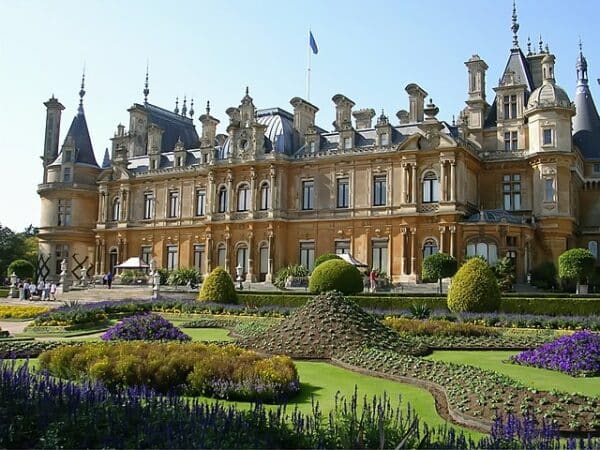
The collection held within the walls of Waddesdon Manor in Oxfordshire is a treasure trove of beautiful and beguiling artefacts. Commissioned by Baron Ferdinand de Rothschild, construction began in 1877 and was completed in 1883. Between Ferdinand, his sister Alice, their cousin Edmond and the present day Lord Rothschild, the house has continued to be filled with a myriad of artworks and objects ever since.
In a collection whose purpose was to demonstrate abundance, not knowing what to admire first is partly the point. Let’s look through the keyhole and revel in a few of the works at Waddesdon in which we can celebrate the colour blue.
The Blue Dining Room of Waddesdon Manor
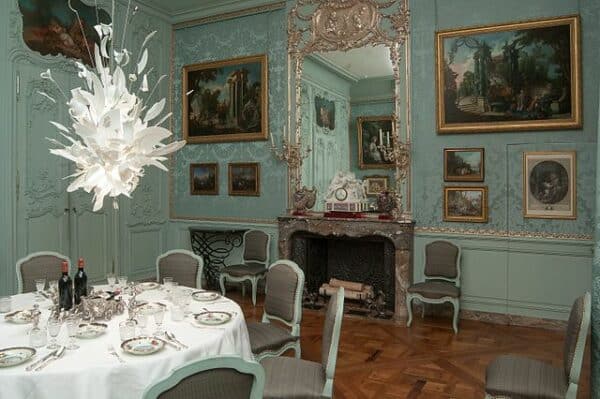
Blue Dining Room, Waddesdon Manor
Where better place to start than in the Blue Dining Room. A room that matches the rest of the house, having been designed in the image of a palatial, French chateaux. The eleven pastel panels that make up the Blue Dining Room actually originate from the hôtel Thiroux de Lailly in Paris (built in 1739-1741). They were acquired by Baron Ferdinand for his London home c.1881, from whence they made their journey to Ayelsbury after being inherited by his sister Alice.
Each panel displays an allegorical work of art carved in oak and coloured a shade of baby blue. A shade that is both gentle and fitting, as each allegory, including emblems of song, sculpture and fishing, are depicted through the figures of children, framed by trophies and cartouches.
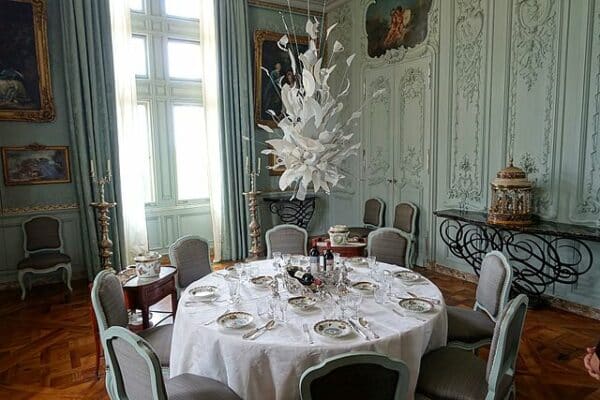
Interior view of the Blue Dining Room featuring Maurer’s Porca Miseria
In current day Waddesdon, the elegant blue panels are contrasted by the explosion of broken white porcelain that is Porca Miseria, a contemporary chandelier by Ingo Maurer (2003). This striking pairing demonstrates a decorative arrangement where old meets new in a setting where both can be enjoyed for their extravagance, matching the opulent style of Waddesdon estate.
Undying Blues in La Noble Pastorale
Moving from one dining room to another we can find a set of three tapestries hanging in an unusual setting, the walls of the manor’s main dining room. Known as ‘La Noble Pastorale’, the cartoons for this series were designed by master of the pastoral Francois Boucher, and were first woven by the Beauvais tapestry manufacturer in 1775.

Detail of La Noble Pastorale, The Fountain of Love, Waddesdon Manor

Detail of La Noble Pastorale, The Flute Player, Waddesdon Manor
Waddesdon’s set was most likely made for King Louis XV, given the particular combination of characters found in scenes known as The Flute Player, The Lunch Party and The Fountain of Love. Each tapestry captures the essence of rural romance and the idyllic life of the countryside, epitomising the pastoral genre. This was a genre popular with the noble classes in France, it reoccurred in art, literature and song dating back to the 15th century. These depictions allowed the wealthy to live out their bucolic fantasies without having to experience the reality and toil of rural labour and life.
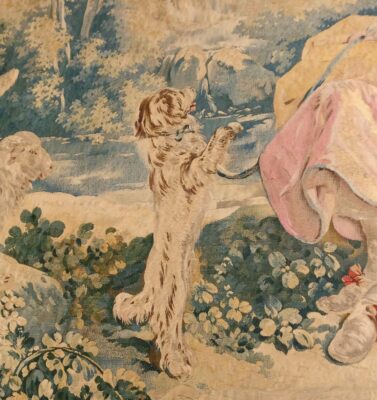
Detail from La Noble Pastorale, Waddesdon Manor
Conserving Colour in Waddesdon’s Tapestries
Something each tapestry has also faced is a battle with light and location, meaning many colours of the warp and weave have faded. In a discussion about colour in tapestries, Nobuko Shibayama, research scientist at the Met Museum, New York, explains how threads absorb light at a molecular level. Exposure to environmental factors are cumulative and fading becomes irreversible. The extensive travelling that the Waddesdon tapestries have undertaken, as well the unusual hanging location in the dining room, where they were subject to smells, light, heat and movement, all naturally contribute to their diminished colour palette.
Cristina Carr, a conservator from the Met, also reports that before the 18th century “dyes were derived from organic materials such as plants, insects and shellfish”, purple dyes came from the secretion of some types of shellfish in fact, and leaves of the indigo plant were used for the blue dyes. The rich shades of blue however, within the tapestries at Waddesdon, have stood the test of time, projecting the calm and serenity of shepherdesses and wind musicians in love.
The Elegant Blue Mantle in Waddesdon’s West Wing
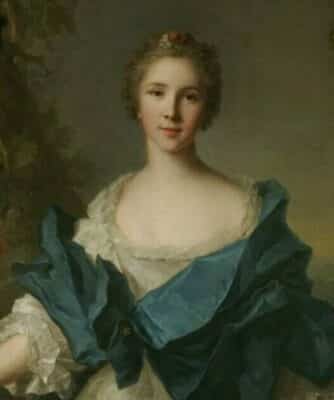
A Woman in a Blue Mantle, oil on canvas, 1742, Waddesdon Manor
Finally, hanging in the south corridor of the West wing, there is the half length oil portrait of A Woman in a Blue Mantleby French painter Jean-marc Nattier (1685-1766). One of many portraits to be found within the collection at Waddesdon.
This is a quintessential example of Nattiers work, his oeuvre consisting of many similar compositions in which beautiful women are dressed in classical attire, set against vegetation or landscape. For those who admire the deep colours of the mantle loosely wrapped around the unknown sitter in this portrait, we offer our own teal blue cashmere scarf, which similarly provides an easy elegance, and warmth.
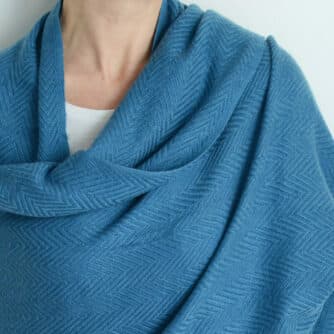
Blue and White Company Teal Cashmere Scarf
Experience Waddesdon
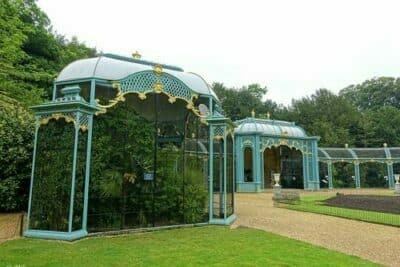
One of the many wonders of Waddesdon is the bird aviary
If you find yourself heading towards Oxfordshire and wish for a fabulous day of exploring, we highly recommend you make a visit to Waddesdon Manor and see the spectacular collection for yourself. In the winter the house and collection are poetically ‘put to bed’ for cleaning and conservation, but in the summer months you can venture far beyond the keyhole and experience the many delights the estate has to offer, including the aviary and extensive gardens.